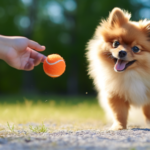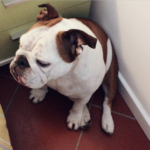It is very important to know how to put an end to dog urine marking in the house because it keeps your house clean and free from dog urine.
A dog who “marks” objects in the house with pee may be a challenging situation to deal with.
Pet owners who deal with urine marking know how aggravating it can be. Urine marking is a territorial habit, unlike simple accidents that may suggest a need for more training or more regular toilet breaks. When a potty-trained dog continues to poop on household items, it might be perplexing.
Fortunately, there are ways to alter your dog’s behavior. Be sure to see your veterinarian before attempting to address your dog’s pee marking problem to rule out any underlying medical issues. An infection in the bladder or urinary system can cause a dog to regularly urinate and should be treated immediately.
In many cases, dog owners are aware with their dog’s unwelcome use of “pee mail,” which is more appropriately referred to as “urine marking.” When it comes to the harmonious cohabitation of humans and canines, “normal” does not imply “acceptable.” This is especially true when it comes to leg lifting.
A dog’s urination is distinct from its marking behavior; a dog urinates because he wants to relieve the sense of fullness in his bladder. Instead, the dog produces a limited bit of pee as a communication method rather than a complete emptying of the bladder as is the case with marking. Pheromones are chemical compounds found in urine that convey significant information about a dog’s age, gender, health, and reproductive state, all of which are fascinating and crucial olfactory reading for dogs, as well as for humans. This explains why dogs are so focused on smelling areas where other dogs have completely eliminated or marked themselves.
Marking is most frequent in male dogs, although it is not confined to them, and it generally occurs around the time of puberty. These changes often occur between the ages of six and nine months, depending on the breed (small breeds mature more quickly than large breeds). With the onset of sexual maturity in male dogs, the increasing levels of testosterone increase the signaling of sexual aptitude and the marking of territorial boundaries.
When compared to intact dogs or dogs who are neutered later in life, dogs who are neutered around the age of six months are less likely to urinate mark, or mark less frequently, than dogs who are neutered earlier in life. That’s not to suggest that all unmodified dogs will show the mark. Training, like with many other things, may go a long way toward reducing marking among all breeds of dogs.
Urine Markings That Are Acceptable
Urine marking is similar to social media when it is used in the real world. While out on a stroll, keep an eye on your dog. The canine version of a Twitter feed is being “read” every time he pauses and sniffs his way across the world. Consider your personal use of social media platforms. Some postings are fast reads before you move on to the next intriguing morsel of information. You “like” some of the postings. It is possible that certain entries will prompt you to write a response or remark of your own. Your dog, on the other hand, makes comparable decisions. As long since he’s utilizing his urine-based social media in a responsible manner, we don’t see anything wrong with this practice, as it provides useful information to both your dog and people who happen to pass by at a later time.
When Urine Marking Becomes a Constant Issue
The marking of the interior of the house is a different tale. When dealing with an indoor marker, it’s important to first determine whether or not you are genuinely dealing with a fundamental housetraining problem. It is possible for young dogs, particularly toy and small-bred dogs (their bladders are smaller, resulting in less output and the need to relieve themselves more frequently), to develop the habit of urinating in the home if they are allowed too much freedom too soon in their lives.
This is typically done out of the owner’s sight, leading the owner to assume that the dog is house-trained in the first place. A “marker” is a canine who has been identified by its owner as having committed an act of theft. In actuality, the dog had never been properly housetrained before being adopted.
As a general rule of thumb, your new dog or puppy should not be permitted to roam the home unaccompanied until he has been accident-free for at least one month (and maybe as long as three full months!). Following this detailed guideline will go a long way toward ensuring that your dog completely comprehends the “house rules” of toileting behaviors.
Marking in Multi-Dog households is a common occurrence.
Marking is a habit that is usually associated with stress and distress. In multi-dog families, indoor marking is more prevalent due to the fact that dogs fight for resources such as bones, toys, ideal lounging locations, access to people, and so on.
It is possible that this rivalry is very subtle, and that people are unaware of it. As an example, to us, a pointed glare or sudden immobility by another dog in the home – possibly defending a toy or a prized location – may appear innocuous, but to a nervous dog, it may appear to be a far more severe scenario (something like the contrast between someone tossing a mild profanity our way and someone waving a switchblade in our direction at an ATM machine).
These common encounters, in which dogs provide and receive information, are handled with ease by the majority of confident, well-adjusted canines, regardless of their breed. Fearful or insecure dogs might suffer, and as a result, they are more likely to mark as a way of releasing their stress and coping mechanisms.
Other Urine Marking Triggers That Are Common
Moving to a new home, having short- and long-term houseguests, visiting animals, the loss of a roommate, hearing strange noises outdoors, seeing strangers when out on walks, sickness, and even rearranging the furniture are all things that our canine companions may find distressing.
Recently acquired dogs frequently mark in an attempt to establish a sense of familiarity in an otherwise unfamiliar environment…. For reasons similar to those mentioned above, an older dog you’ve had for a while may mark during or after a visiting animal’s stay in your house, or even mark human guests’ belongings when they’re left out. I’m sorry, but this doesn’t seem familiar…
Please allow me to take care of it.” The act of marking is transformed into an attempt to restore a feeling of normalcy. When you start your first day at a new job, it’s like putting your favorite family photo on your desk to greet you. “See! I do have a place in this place. “All of my belongings have arrived!”
In the same way that people do, our dogs become accustomed to things being a particular way. And, just like people, some dogs adapt better to change than others. Following a significant life transition, owners commonly claim that their dogs began marking out of “spite.”
However, spite and vindictiveness are emotions that are unique to humans. Dogs, on the other hand, are not wired in that manner. Additionally, keep in mind that pee (as well as feces) is a highly valuable source of information for dogs. A pool of pee or a mound of feces is comparable to a front-page New York Times article; it is excellent reading material! If your dog was attempting to “get back at you” for whatever, why would he leave you such a thoughtful gift?
If you possessed the keen nose of your canine partner, you’d turn to the aroma of your dog’s urine to give you clues about his emotional condition, just like your dog does. With regard to this practice, I believe we can all agree that we are thankful we are not canines. Believe your trainer when she explains it’s not spite, but stress that’s causing the problem.
It is possible that unpleasant encounters away from home will result in incidences of marking at home, just as a difficult day at work may induce us to grab for a bottle of wine as soon as we get through the door.
Consider the following scenario: If you have a dog who is fearful and finds walks stressful, he may not mark throughout the walk (since marking would draw attention to himself and nervous dogs are more likely to desire to blend in rather than stand out), but the residual effects of the stress-inducing event may cause him to mark to help him cope once he returns home.
Medical Justifications for Peeing Indoors
When your dog’s behavior changes suddenly, it’s important to rule out any underlying medical issues that may be causing the behavior shift in the first place. A medical issue will not be overcome by any amount of behavioural adjustment. If you are unable to quickly determine the likely stress-related cause of your dog’s behavior change, we propose that you take him to the veterinarian. A dog suffering from a urinary tract infection (UTI) may have an almost continual urge to “go,” and may release tiny volumes of pee on a regular basis throughout the day.
How to Prevent Your Dog From Urinating in Public
The following measures, either alone or in combination, can aid in the prevention of marking:
- Make use of management. The first step in resolving a marking problem is to practice vigilant management in order to prevent the repetition of undesirable conduct. Keep a watchful check on your dog – no unattended time allowed! – so that you may intercept any attempts to mark and divert his efforts to “go” outside as soon as they occur.
When you are unable to oversee your dog, consider restricting him or her to an x-pen or crate, or using baby gates to create a small enough space to discourage soiling. If the marking is restricted to a single room, prevent anybody from entering that room for at least a month (the same benchmark as housetraining). Several consumers have reported success in shifting their dogs’ food and water to the issue location, owing to the fact that most dogs will not mess where they eat. Sometimes simply applying rigorous management to prevent the habit will suffice in terms of providing long-term development.
- Decrease your level of tension. Determine which situations in your dog’s life are likely to cause him stress. Some pressures might be difficult to manage. For example, many dog owners believe that showering their pets with limitless goodies while expecting nothing in the way of basic obedience is an excellent way to express affection. Unfortunately, a lack of fundamental structure frequently adds to anxiety, particularly in families with numerous dogs. I am not a fan of rigorous “leadership” norms, but feel dogs benefit from being taught a basic competence that allows them to work in cooperation with their humans, who have the responsibility of ensuring the well-being of everyone in the home.
If your dog’s marking occurs primarily when you aren’t home, he or she may be concerned about being alone. Make careful to keep departures and arrivals as low-key as possible to decrease the intensity of an already emotional event for your canine companion. In addition to teaching your dog to tolerate time away from you – even while you’re at home – you can also aid lessen anxiety when you’re away. (For additional information on separation anxiety and isolation discomfort in dogs, see “Separation Anxiety in Dogs: Symptoms and How to Modify the Behavior,” published in October 2016.)
tIn addition, be aware of any potentially frightening sounds That may be producing anxiety – for example when on a trash day, the garbage truck causes an ear-piecing beep when backing up. Once you’ve discovered the source of your dog’s emotional response, you may often successfully counter-condition his behavior and behavior.
Anxiety may be a difficult condition to deal with and overcome. Some dogs respond favorably to homeopathic treatments or floral essence mixes that are intended to relieve anxiety in them, according to research. The product Adaptil, which uses pheromones and is available as a plug-in diffuser or as a collar, is another alternative. Pheromones crucial in the bonding process between a nursing dog and her children are released by Adaptil products, sending an olfactory message of comfort and security to the pups and their mothers. It is possible that pharmacological intervention will be required in some circumstances.
- Wipe down any soiled areas. To fully clean pee stains in the home, use an enzymatic cleanser such as Nature’s Miracle to remove the urine enzymes. Keep ammonia-based cleansers to a minimum. Urine contains ammonia, and products containing ammonia might induce further marking. If you are moving into a property that has previously been occupied by dogs, you might consider having the carpet professionally cleaned or replaced to lessen your dog’s propensity to mark over existing animal scent. If this is not an option, a black light can be used to search for potential issue areas instead.
fifteen4. Take into consideration neutering. Even if neutering your dog, especially prior to the onset of sexual maturity (twenlve to 15 months), is likely to reduce or eliminate his desire to mark, since it prevents the impact of hormones on his behavior.
- Discourage any and all marking, including outside. In certain situations, the act of marking develops into a well-honed habit that persists long after external stresses have been removed or the animal has been neutered (especially among dogs neutered later in life). Even if you’re working outside, I advocate drawing a strong line when it comes to marking in such situations. Take the chance to let your dog to completely empty his bladder before swiftly and casually interrupting any additional efforts to leave his calling card across the area. It doesn’t have to be a dramatic interruption; simply continue walking as your dog attempts to mark, almost as if you hadn’t realized anything was going on.
It should be noted that some people believe that preventing this activity outside might increase a dog’s stress, particularly in nervous dogs. It may be necessary to experiment in order to determine which strategy is most effective in improving the situation with your dog.
- Consider wearing a belly band. If you are unable to physically watch or properly confine your dog in order to reduce his marking, a cloth belly band may be beneficial. A belly band is worn around your dog’s waist, similar to a tube top, and covers his penis. While the garment is worn, the band frequently discourages any amount of urination, or, at the very least, absorbs the urine and protects your house and furnishings from stains. This is one good way to train your dog not to mark with urine.
Seventh and maybe most crucially, don’t punish! It is important to remember that incorrect marking is a stress reaction. It’s one thing to calmly interrupt a dog while he’s marking; it’s quite another to yell at him. Reprimanding him after the fact would just aggravate the situation. Unless you interfere while the behavior is taking place, your dog will not associate your dissatisfaction with his marking. He may appear to be remorseful when you admonish him, but that expression is an attempt to satisfy you at the time – not because he recognizes that his behavior, which occurred however long ago, is unwelcome in this situation.
A similar caution should be exercised when confronting him in circumstances where he is likely to mark. “There will be no marking while I’m away!” “You leave Grandma’s stuff alone!” or similar phrases will only help to enhance your dog’s uneasiness since he can’t comprehend your words but recognizes a harsh, angry tone in your voice, which will only intensify his worry.
Three important stps to curb the effects
- Maintain constant and active monitoring over your dog. When you are not looking after him, employ a management item (such as a crate, gate, exercise enclosure, or belly band) to keep him from marking during the time you are not observing him.
- Take into consideration what could be causing your dog tension. Is there a threat from another dog? Is there a lack of structure? Is it normal for a smoke alarm to beep continually, signaling that the battery is running low? Remove any tensions that you can from your life.
- Use an enzymatic cleanser on any area that has been “marked” with a permanent marker. Your dog’s nose is significantly more sensitive than yours, and even the faintest scent of pee may act as a cue for him to mark his territory once more. Examine the area with a black light to ensure that you haven’t overlooked any areas that need to be cleaned.






